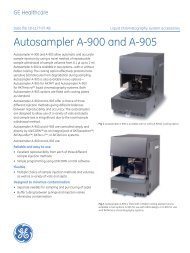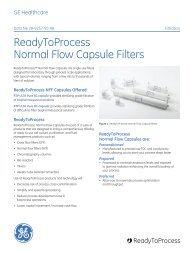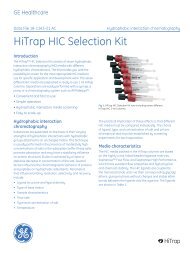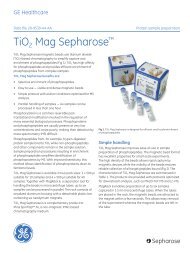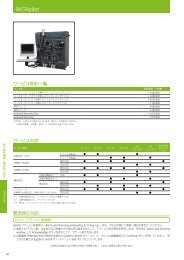StrepTactin Sepharose High Performance StrepTrap HP
StrepTactin Sepharose High Performance StrepTrap HP
StrepTactin Sepharose High Performance StrepTrap HP
You also want an ePaper? Increase the reach of your titles
YUMPU automatically turns print PDFs into web optimized ePapers that Google loves.
M r<br />
188 000<br />
98 000<br />
62 000<br />
49 000<br />
38 000<br />
28 000<br />
17 000<br />
14 000<br />
6 000<br />
3 000<br />
1 2 3 4 5 6 7<br />
Lane<br />
1. Molecular weight markers<br />
2. Flowthrough, individual HisTrap <strong>HP</strong><br />
3. Eluted pool, individual HisTrap <strong>HP</strong><br />
4. Flowthrough, HisTrap <strong>HP</strong> + <strong>StrepTrap</strong> <strong>HP</strong><br />
5. Eluted pool, HisTrap <strong>HP</strong> + <strong>StrepTrap</strong> <strong>HP</strong><br />
6. Eluted pool, individual <strong>StrepTrap</strong> <strong>HP</strong><br />
7. Flowthrough, individual <strong>StrepTrap</strong> <strong>HP</strong><br />
Fig 3. SDS-PAGE analysis (reduced conditions) comparing individual<br />
purifications on HisTrap <strong>HP</strong> 1 ml and <strong>StrepTrap</strong> <strong>HP</strong> 1 ml with a combined,<br />
two-step affinity purification on both columns.<br />
Regeneration with NaOH<br />
Regenerating <strong>StrepTrap</strong> <strong>HP</strong> prior to performing the next<br />
purification will help retain chromatographic performance<br />
and promote cost-effective use. The columns can easily be<br />
regenerated using two protocols either with 0.5 M NaOH<br />
(approx. 10 min) or 1 mM HABA (2-[4’-hydroxy-benzeneazo]<br />
benzoic acid (approx. 25 min). This example shows<br />
regeneration with NaOH, which is fast, simple and effective.<br />
GAPDH-Strep(II) (M r ~37 400) was purified on <strong>StrepTrap</strong><br />
<strong>HP</strong> 1 ml. Six repetitive runs were made with regeneration<br />
using 0.5 M NaOH between each run. Figure 4 shows the<br />
overlayed chromatograms from these six runs, illustrating<br />
the very high reproducibility of <strong>StrepTrap</strong> <strong>HP</strong> columns.<br />
Further analysis by capillary electrophoresis demonstrated<br />
high purities (more than 97% in all six runs, data not shown),<br />
a result confirmed by SDS-PAGE analysis (Fig 5). Recovery<br />
was also high (greater than 80%) and very consistent<br />
throughout the entire study (Fig 6). The UV measurements<br />
were performed using a plate reader.<br />
Column:<br />
<strong>StrepTrap</strong> <strong>HP</strong> 1 ml<br />
Sample:<br />
Strep(II)-tagged glyceraldehyde-phosphodehydrogenase<br />
(GAPDH-Strep[II], M r ~37 400), 1.0 mg/ml in E. coli lysate<br />
Sample volume: 1 ml<br />
Binding buffer: 100 mM Tris-HCl, 150 mM NaCl, 1 mM EDTA, pH 8.0<br />
Elution buffer:<br />
2.5 mM desthiobiotin in binding buffer<br />
Regeneration:<br />
3 ml distilled water, 3 ml 0.5 M NaOH, 3 ml distilled water<br />
Re-equilibration: 5 ml binding buffer<br />
Flow rate:<br />
1.0 ml/min<br />
(0.5 ml/min with NaOH)<br />
System:<br />
ÄKTAexplorer <br />
Elution buffer<br />
mAU<br />
%B<br />
100<br />
6000<br />
5000<br />
4000<br />
3000<br />
2000<br />
1000<br />
0<br />
0<br />
0 5 10 15 20 25 ml<br />
Fig 4. Six repetitive GAPDH-Strep(II) purification runs on the same<br />
<strong>StrepTrap</strong> <strong>HP</strong> 1 ml column.<br />
M r<br />
97 000<br />
66 000<br />
45 000<br />
30 000<br />
20 100<br />
14 400<br />
1 2 3 4 5 6 7 8<br />
Lane<br />
1. Low molecular weight markers<br />
2. Start material, E. coli lysate with GAPDH-Strep(II)<br />
3. Run 1, eluted pool<br />
4. Run 2, eluted pool<br />
5. Run 3, eluted pool<br />
6. Run 4, eluted pool<br />
7. Run 5, eluted pool<br />
8. Run 6, eluted pool<br />
Fig 5. SDS-PAGE analysis (reduced conditions) of the six repetitive<br />
purifications runs in the regeneration study shows excellent<br />
reproducibility.<br />
80<br />
60<br />
40<br />
20<br />
<br />
Data file 28-9136-31 AB<br />
Recovery (%)<br />
100<br />
90<br />
80<br />
70<br />
60<br />
50<br />
40<br />
30<br />
20<br />
10<br />
0<br />
1 2 3 4 5 6<br />
Run<br />
Fig 6. Recovery in the eluted fractions was retained over six<br />
purification runs.



![[PDF] マニュアル GradiFrac](https://img.yumpu.com/22037825/1/190x253/pdf-gradifrac.jpg?quality=85)
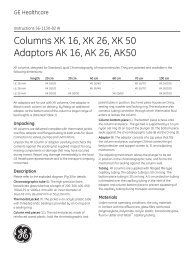
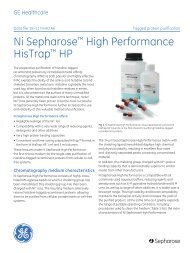
![[PDF] Sample preparation for analysis of protein, peptides and ...](https://img.yumpu.com/21549715/1/190x257/pdf-sample-preparation-for-analysis-of-protein-peptides-and-.jpg?quality=85)
![[PDF] Data File: rProtein A Sepharose Fast Flow](https://img.yumpu.com/21549316/1/190x253/pdf-data-file-rprotein-a-sepharose-fast-flow.jpg?quality=85)
![[PDF] MBP-tagged protein purification](https://img.yumpu.com/21548507/1/184x260/pdf-mbp-tagged-protein-purification.jpg?quality=85)
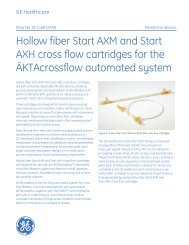
![[PDF] AKTA ready system Data file](https://img.yumpu.com/21540925/1/190x253/pdf-akta-ready-system-data-file.jpg?quality=85)
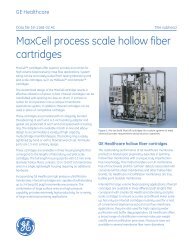
![[PDF] Data File - rProtein A/Protein G GraviTrap](https://img.yumpu.com/21539052/1/190x253/pdf-data-file-rprotein-a-protein-g-gravitrap.jpg?quality=85)
